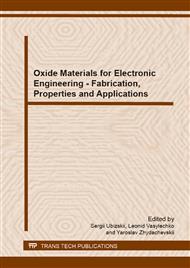[1]
M.D. McCluskey, M.C. Tarun, S.T. Teklemichael, Hydrogen in oxide semiconductors, Journal of Materials Research 27 (2012) 2190-2198.
DOI: 10.1557/jmr.2012.137
Google Scholar
[2]
S. Bandyopadhyay, G.K. Paul, S.K. Sen, Study of optical properties of some sol–gel derived films of ZnO, Solar Energy Materials and Solar Cells 71 (2002) 103.
DOI: 10.1016/s0927-0248(01)00047-2
Google Scholar
[3]
Y. Natsume, H. Sakata, Zinc oxide films prepared by sol-gel spin-coating, Thin Solid Films 372 (2000) 30.
DOI: 10.1016/s0040-6090(00)01056-7
Google Scholar
[4]
P. Nunes, D. Costa, E. Fortunato, R. Martins, Performances presented by zinc oxide thin films deposited by r.f. magnetron sputtering, Vacuum 64 (2002) 293.
DOI: 10.1016/s0042-207x(01)00323-2
Google Scholar
[5]
D.C. Look, D.C. Reynolds, C.W. Litton, R.L. Jones, D.B. Eason, G. Gantwell, Characterization of homoepitaxial p-type ZnO grown by molecular beam epitaxy, Applied Physics Letters 81 (2002) 1830.
DOI: 10.1063/1.1504875
Google Scholar
[6]
K. Tominaga, T. Takao, A. Fukushima, T. Moriga, I. Nakabayashi, Amorphous ZnO–In2O3 transparent conductive films by simultaneous sputtering method of ZnO and In2O3 targets, Vacuum 66 (2002) 505.
DOI: 10.1016/s0042-207x(02)00123-9
Google Scholar
[7]
N. Naghavi, C. Marcel, L. Dupont, A. Rougier, J.B. Leriche, C. Guery, Structural and physical characterisation oftransparent conducting pulsed laser deposited In2O3–ZnOthin films, Journal of Materials Chemistry 10 (2000) 2315.
DOI: 10.1039/b002094j
Google Scholar
[8]
M. Krunks, E. Mellikov, Zinc oxide thin films by the spray pyrolysis method, Thin Solid Films 270 (1995) 33.
DOI: 10.1016/0040-6090(95)06893-7
Google Scholar
[9]
T. Shuler, M.A. Aegerter, Optical, electrical and structural properties of sol gel ZnO:Al coatings, Thin Solid Films 351 (1999) 125.
DOI: 10.1016/s0040-6090(99)00211-4
Google Scholar
[10]
Y. Natsume, H. Sakata, Electrical and optical properties of zinc oxide films post-annealed in H2 after fabrication by sol–gel process, Materials Chemistry and Physics 78 (2002) 170.
DOI: 10.1016/s0254-0584(02)00314-0
Google Scholar
[11]
E.J. Luna-Arredondo, A. Maldonado, R. Asomoza, D.R. Acosta, M.A. Melendez-Lira, M. de la L. Olvera, Indium-doped ZnO thin films deposited by the sol–gel technique, Thin Solid Films 490 (2005) 132.
DOI: 10.1016/j.tsf.2005.04.043
Google Scholar
[12]
N.R.S. Farley, C.R. Staddon, L.X. Zhao, K.W. Edmunds, B.L. Gallagher, D.H. Gregory, Sol-gel formation of ordered nanostructured doped ZnO films, Journal of Materials Chemistry 14 (2004) 1087.
DOI: 10.1039/b313271d
Google Scholar
[13]
M. Ohyama, H. Kozuka, T. Yoko, Sol-gel preparation of ZnO films with extremely preferred orientation along (002) plane from zinc acetate solution, Thin Solid Films Vol. 306 (1997), p.78
DOI: 10.1016/s0040-6090(97)00231-9
Google Scholar
[14]
K. Vanheusden, C.H. Seager, W.L. Warren, D.R. Tallant, J.A. Voigt, Correlation between photoluminescence and oxygen vacancies in ZnO phosphors, Applied Physics Letters 68 (1996) 403.
DOI: 10.1063/1.116699
Google Scholar
[15]
B. Lin, Z. Fu, Y. Jia, Green luminescent center in undoped zinc oxide films deposited on silicon substrates, Applied Physics Letters 79 (2001) 943.
DOI: 10.1063/1.1394173
Google Scholar
[16]
V. Srikant and D.R. Clarke, On the optical band gap of zinc oxide, Journal of Applied Physics 83 (1998) 5447.
DOI: 10.1063/1.367375
Google Scholar
[17]
R. Loudon, The Raman effect in crystals, Advances in Physics 13 (1964) 423.
Google Scholar
[18]
C.A. Arguello, D.L. Rousseau and S.P.S. Porto, First-Order Raman Effect in Wurtzite-Type Crystals, Physical Review 181 (1969) 1351.
DOI: 10.1103/physrev.181.1351
Google Scholar
[19]
K.A. Alim, V.A. Fonoberov, M. Shamsa, A.A. Balandin, Micro-Raman investigation of optical phonons in ZnO nanocrystals, Journal of Applied Physics 97 (2005) 124313.
DOI: 10.1063/1.1944222
Google Scholar
[20]
Y.W. Chen, Y.C. Liu, S.X. Lu, C.S. Xu, C.L. Shao, C. Wang, J.Y. Zhang, Y.M. Lu, D.Z. Shen, X.W. Fan, Optical properties of ZnO and ZnO:In nanorods assembled by sol-gel method, Journal of Chemical Physics 123 (2005) 134701.
DOI: 10.1063/1.2009731
Google Scholar
[21]
S. Mridha and D. Basak, Effect of concentration of hexamethylene tetramine on the structural morphology and optical properties of ZnO microrods grown by low-temperature solution approach, Physica Status Solidi A 206 (2009) 1515.
DOI: 10.1002/pssa.200824497
Google Scholar
[22]
K. Vanheusden, C.H. Seager, W.L. Warren, D.R. Tallant, J.A. Voigt, Correlation between photoluminescence and oxygen vacancies in ZnO phosphors, Applied Physics Letters 68 (1996) 403.
DOI: 10.1063/1.116699
Google Scholar
[23]
K. Vanheusden, W.L. Warren, C.H. Seager, D.R. Tallant, J.A. Voigt, Mechanisms behind green photoluminescence in ZnO phosphor powders, Journal of Applied Physics 79 (1996) 7983.
DOI: 10.1063/1.362349
Google Scholar
[24]
S.A. Studenikin, N. Golego, M. Cocivera, Carrier mobility and density contributions to photoconductivity transients in polycrystalline ZnO films, Journal of Applied Physics 84 (1998) 2287.
DOI: 10.1063/1.372194
Google Scholar
[25]
A. Van Dijken, E.A. Meulenkamp, D. Vanmaekelbergh, A. Meijerink, The luminescence of nanocrystalline ZnO particles: the mechanism of the ultraviolet and visible emission, Journal of Luminescence 87–89 (2000) 454.
DOI: 10.1016/s0022-2313(99)00482-2
Google Scholar
[26]
A. Van Dijken, J. Makkinje, A. Meijerink, The influence of particle size on the luminescence quantum efficiency of nanocrystalline ZnO particles, Journal of Luminescence 92 (2001) 323.
DOI: 10.1016/s0022-2313(00)00262-3
Google Scholar
[27]
J.H. Evans-Freeman , M.M. El-Nahass , A.A.M. Farag, A. Elhaji, Current transport mechanisms and deep level transient spectroscopy of Au/n-Si Schottky barrier diodes, Microelectronic Engineering 88 (2011) 3353–3359.
DOI: 10.1016/j.mee.2011.07.001
Google Scholar
[28]
H. Deuling, E. Klausmann, A. Goetzberger, Interface states in Si-SiO2 interfaces, Solid-State Electronics 15 5 (1972) 559.
DOI: 10.1016/0038-1101(72)90157-8
Google Scholar
[29]
E.H. Nicollian, J.R. Brews, MOS Physics and Technology, Wiley, New York, 1982.
Google Scholar
[30]
R. Castagne, A. Vapaille, Description of the SiO2 Si interface properties by means of very low frequency MOS capacitance measurements, Surface Science 28 (1971) 157.
DOI: 10.1016/0039-6028(71)90092-6
Google Scholar


